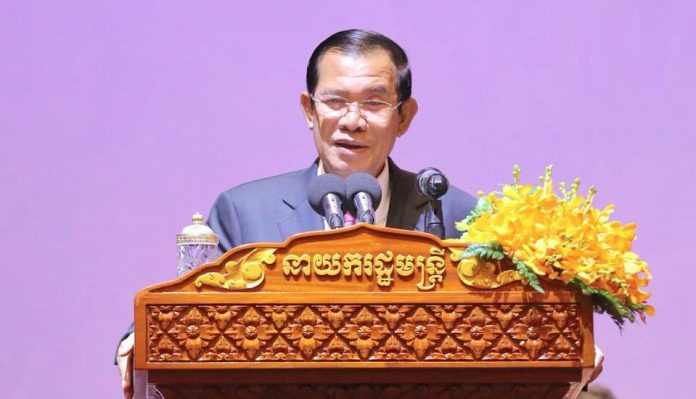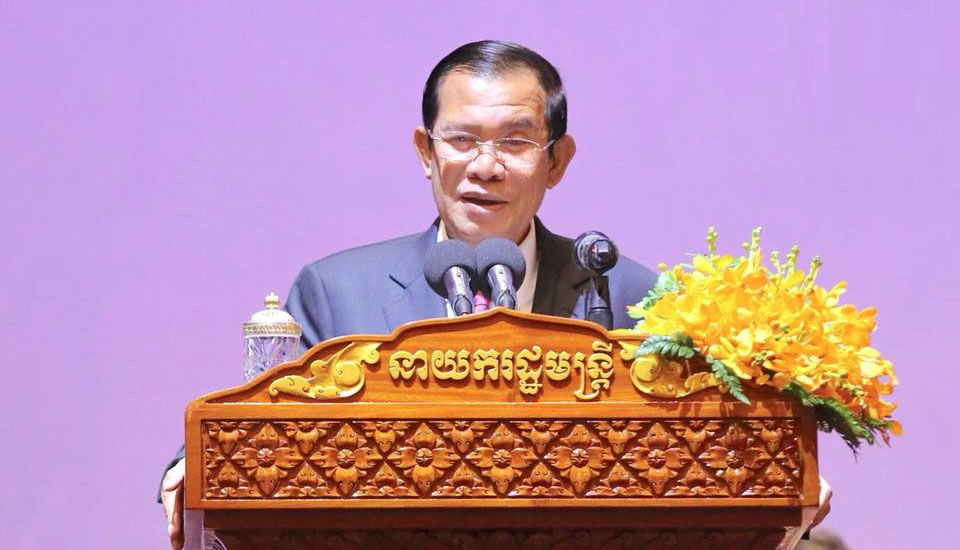2018 Cambodia Outlook Conference: Partnership between Cambodia Development Resource Institute (CDRI) and ANZ Royal Under the theme: “Science and Technology for Industrialization, Economic Growth and Development of Cambodia”
[Unofficial Translation]
Samdech, Excellencies, Ladies, Gentlemen!
Today, I am delighted to attend the opening of “2018 Cambodia Outlook Conference” under the theme of “Science and Technology for Industrialization, Economic Growth and Development of Cambodia”. This is the twelfth time I have attended this important annual conference which provided policy inputs to contribute to the Royal Government’s development effort.
Taking this opportunity, I would like to express my high appreciation to Cambodia Development Resource Institute (CDRI) and ANZ Royal Bank for continuing this initiative to review achievements, challenges and how we can work together to address those challenges and exchanges views on the future of Cambodia for the sake of national interest.
The theme of today’s conference is very relevant to Cambodia as it is creating the foundation for long-term growth while striving to build institutional capacity, modernize technical material base, strengthen the effectiveness of the information technology and promote the construction and efficiency of ITC backbone infrastructure, especially to become an upper-middle income country in 2030 and high-income country in 2050. In fact, global scientific and technological development is a key determinant, especially in the context of Industrial Revolution 4.0 in which science and technology will vastly improve in four fields, viz.digital sector, bio-technology, material physics and energy. Moreover, the combination of science and these four fields of technology will accelerate and deepen unprecedented automation and change in all aspects of the lives of human beings. I can envisage various means for supporting long-term development of Cambodia. Among them, science and technology will play an important role and be indispensable to the New Growth Strategy and Cambodia’s long-term vision. Right now, I would like to highlight three major connections of science and technology that include:
- Development of science and technology will help enhance productivity, growth, knowledge and technical capacity which will help Cambodia builds a knowledge-based economy like developed countries. This is an important aspect to be noted while 65% of Cambodia’s population is below 30, therefore Cambodia must fully capitalized on this favorable demographic dividend in order to achieve its development goals. In this regard, Cambodia will look at policy and measures to ensure that our youth is fully capable to get the most out of the science and technology sector.
- Development of physical infrastructure is vital to economic growth and development, but technological infrastructure and innovation are even more important for Cambodia’s enhanced competitiveness and economic diversification. In fact, countries like China, India, Brazil, Singapore, Philippines, Thailand, Malaysia are the great examples of the use of science and technology as well as trade openness for this sector.
- Major trends, particularly new digital industrial technology, known as the Industrial Revolution 4.0 or Smart Factory, will push producers in all industries to pay attention to the internet of things, that is the connection of appliances, devices etc. to the internet to interchange data with the production process and the global value chain in a convenient manner. In particular, this vast data will help us make better informed decisions and enhance the productivity in all sectors through the use of artificial intelligence that enable machines to replace human beings and financial technologies which make payment easier and more effective. In this regard, the fourth industrial revolution will push companies to change their operation style and Cambodia must be able to adapt to this technological development.
[Comments start]
Fourth Industrial Revolution and Employments
Let me speak a bit on this. Technology is making rapid development and it surely drives economic growth and progress of every country. However, let us think clearly on this point. When robots take up the works of human, where can those people find their jobs? That will be social issues that are coming in the fourth industrial revolution. It is not an issue that goes separately on its own but will become a challenge to social safety net.
In our country, intensive labor industry is in process along with the issuance of a new policy for 2015-25 industrial development, which aims to attract processing, higher value added, and high-tech industry. As we could see now some countries have already used robots to serve food. We may wonder where those people who served food would go. We are may be happy with the progress made in technology but we must think about unavoidable human-related consequences that would include issue of people being sacked by high-tech companies to make way for robots. How could they survive? How could they be sure to find jobs? How could they make their livings?
We must foresee these problems and think of measures to guarantee that people will not lose their jobs because of rapid technological development. They must not be misplaced in any social progress.
[Comments End]
Overall, the global trend is changing rapidly, and the use of science and technology as well as imported technology, domestic technology development, and technology absorption of Cambodians become more widespread and take root in the agriculture, industry, and service sectors in parallel with the socio-economic development. This situation stems from the improvement in the innovation-friendly environment, rapid development in electricity and telecommunication infrastructure, expansion of connectivity to global and regional production chain and growth of domestic human resource. However, lack of skilled workforce and inadequate human resources have hindered the development pace of technological and technical sector of Cambodia. It is, therefore, vital to promote investment in scientific and technological potentials to prepare ourselves for new opportunities as well as challenges in the future. This task requires considerable time but I believe we are moving in the right direction. The National Science and Technology Council (NSTC) was established in 2014, and the National Master Plan of Science and Technology 2014-2020 has been adopted. Currently, the NSTC is actively involved in the preparation of policy related to science, technology, and innovation, by cooperating with various line ministries, institutions, and stakeholders. In this connection, we fully support the Ministry of Education Youth and Sports (MoEYS)’s effort to promote science, technology, engineering, and mathematics known as “STEM” from primary to post-secondary level.
I would like to take this opportunity to highlight certain points about the development of science and technology sector for underpinning Cambodia’s economic growth and development as follows:
- While maintaining the growth rate at 7% per annum in the medium term, Cambodia’s economy will move beyond agriculture and garment. Currently, the number of high value-added and emerging enterprises especially home appliance and electronics sectors increased from 5.1% of total enterprises in 2012 to 7.1% in 2017. At the same time, export of electrical and electronic devices has surged from 4.7% of total export in 2011 to 8.3% in 2016. Export of non-garment products, including footwear reached 16% of the total export in 2016, exceeding the target of 15% in 2025 which is the planned indicator in the Industrial Development Policy (IDP) 2015-2025.
- In fact, our science and technology sector are lagging behind other ASEAN countries. Spending on R&D is still limited, only 0.12% of GDP in 2015, in comparison with 0.63% in Thailand, and 1.3% in Malaysia. Given its significance, the RGC is committed to increasing spending on R&D to 0.2% of GDP in 2020, to 1% in 2025, and to 1.5% in 2030. In this context, we also pay attention to researchers, as the number of researchers in Cambodia, as of 2015, is only 50 people per 1 million (of which 30 are full-time researchers). Cambodia plans to increase the number of full-time researchers up to 2 000 by 2030.
To develop the science and technology sector, Cambodia will focus on building the supporting base as follow:
- Developing skilled workface. Cambodia will pay high attention to STEM and technical and vocational training by supporting the linkage between education and enterprises. Cambodia will also create a national accreditation system for awarding prize to individuals and groups that contribute to the promotion of science and technology.
- Promoting research and development network and high quality physical infrastructure. Cambodia will promote public-private partnership mechanism to support the establishment of physical infrastructure for research and development and facilitate technology transfer and market penetration. With that, Cambodia will encourage the private sector to invest more on product R&D and new production process, encourage national and international cooperation between industrial enterprises, research institutes and universities to share information on technologies and market access.
- Further strengthening institutional, policy and regulatory frameworks. Cambodia will effectively strengthen the implementation of the intellectual property law, related regulations and the improvement of other regulation frameworks in order to encourage and to support entrepreneurs and scientists to innovate and sell their technology products and new services.
- Inspiring the participation of public in science and technology sector. Cambodia will promote public awareness on the importance of science and technology through nurturing the talents, knowledge on science, technology, engineering and mathematics that promote and add value to science and technology development.
Overall, Cambodia must promote science and technology sectors in order to accelerate economic growth and expand the growth base to actively participate in developing the region and the world with equality and equal rights. On the other hand, technology sector will have both positive and negative consequences on politics, economy and society that must carefully and comprehensively reviewed. Technology will have an impact on information system that can be distributed quickly without verification and classification which lead to unrest, insecurity and unexpected change. The technological improvement help promote automation and productivity, minimize defects which will create a new competing ground called Digital Economy. In addition, technology will affect employment sector and require higher knowledge and skill. Science and technology contribute to less interaction, more independent lifestyle, higher ownership, changing lifestyle that will establish new society called Digital Society. However, the preparation of a strong foundation of technology and science enabling us to grab opportunity and manage risk is imperative.
[Comments Start]
Digital Society Transforms Human Behaviors
I wish to bring up one little true behavioral development. Have you ever noticed anything in the last few years? Previously, we Khmer were very friendly with each other, and would be talking endlessly when we met. At present, we kept silent when we met. Everyone is staring at their smartphones. They do not talk anymore. This is what digital society gives us. This is also an issue in marriage life. Where they would talk on various issues to each other they now stick their eyes on their phones separately. It is obvious. Human friendliness between one another has reduced […]
[Comments End]
With this spirit, I believe that we all can work together to realize our technology and science ambitions, prevent negative consequences and to ensure peace, stability, sustainable development and prosperity in Cambodia.
Last but not least, I would like to express my appreciation to H.E. Sok Siphana for his contribution to the progress and development CDRI during his 7-year term and being a great role model for everyone at CDRI. I believe that His Excellency will have opportunity to cooperate further with CDRI institution in the future. I would also like to congratulate H.E Mey Kalyan who has been appointed as the Chairman of the Board to succeed H.E Sok Siphana. I would like to wish His Excellency great success to help further develop CDRI.
Finally, with the opening of the “2018 Cambodia Outlook Conference” under the theme of “Science and Technology for Industrialization, Economic Growth and Cambodia Development” at this moment, I would like to wish you all success and fruitful outcome from this conference and happiness, prosperity, and success in all your endeavors./.







